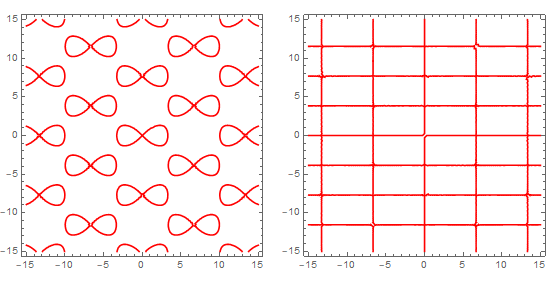Although the other answers provide correct values, I prefer that by J.M. since it touches the essence of the issue, nonetheless I'm going to provide an exact result with a bit of desirable explanation, therefore it is crucial to mention at first one of the basic elliptic integrals:
$$\int_{\infty}^{x}\frac{dt}{\sqrt{4t^3-g_2 t-g_3}}=\wp^{-1}(x;g_2,g_3)$$
that is $\wp$ - the Wierstrass elliptic function, i.e is the inverse function to the above elliptic integral expressed as a function of $x$, while $g_2$ and $g_3$ are the Weierstrass invariants. The main problem related to symbolic calculation of elliptic integrals concerns of an appropriate domain of definitions (in the complex plane) of the the elliptic functions and its inverses.
While $\wp$ is a doubly periodic in the complex plane, it is defined in the whole complex plane except for a discrete (however infinite) set of the lattice points, therefore we have to deal with $\wp^{-1}$ carefully. Here we plot only a finite sector of a lattice:
Graphics[
Point[ Flatten[
Table[n {-1/2, -3/2} + m {Sqrt[1], 1/Sqrt[3]},
{m, -10, 10}, {n, -10, 10}], 1]]]

which one can simply calulate with the Weierstrass half-periods. All those functions are implemented in Mathematica
?**Weierstrass**

Among them there are new in version 11.2: WeierstrassE1, WeierstrassHalfPeriodW1, WeierstrassInvariantG2, WeierstrassEta1 etc.
Unfortunately they (WRI) have not improved various unsatisfactory issues related to calculations of elliptic functions and intgrals.
For quite a similar problem see Why does Integrate declare a convergent integral divergent?
Of course, the integral should be real and that is a mathematical error. However, as there are many similar problematic issues (see e.g. this anser), one should expect the revision of symbolic integration of elliptic functions by WRI rather than a removing a simple bug.
To give a clarifying symbolic solution of the problem at hand, let's rewrite the integral symbolically:
$$\int_{0}^{\infty} \frac{dz}{\sqrt{\frac{7}{10}+\frac{3}{10}(1+z)^3}}=2\sqrt{\frac{10}{3}} \int_{1}^{\infty} \frac{dt}{\sqrt{\frac{28}{3}+4t^3}}=-2\sqrt{\frac{10}{3}} \int_{\infty}^{1} \frac{dt}{\sqrt{\frac{28}{3}+4t^3}}=\\=-2\sqrt{\frac{10}{3}} \wp^{-1}(1;0,-\frac{28}{3}) $$
The last function is the inverse of the Weierstrass elliptic function $\wp$, and the integral should be calculated automatically with Mathematica in a symbolic way however it fails. Nonetheless, there are appropriate symbolic tools to verify our reasoning.
N[-2 Sqrt[10/3] InverseWeierstrassP[1, {0, -(28/3)}], 25] // Chop
3.305075828454599464535302
Plot[ WeierstrassP[-Sqrt[(3/40)] t, {0, -(28/3)}] - 1, {t, -20, 20},
PlotRange -> {-5, 20},
Epilog -> {PointSize[0.025], Red, Point[{3.3050758284545996`, 0}]}]

Let's check it numerically in another way:
t /. FindRoot[ WeierstrassP[-Sqrt[(3/40)] t, {0, -(28/3)}] - 1, {t, 3}]//Chop
3.30508
A hint why there is - 3.85013 I in the earlier version:
N[-2 Sqrt[10/3] InverseWeierstrassP[0, {0, -(28/3)}]]
-2.22287 + 3.85013 I
and from the plot it is clear why the system (unfortunately) fails to find automatically the argument of the inverse function.
GraphicsRow@Table[
ContourPlot[ p[WeierstrassP[-Sqrt[(3/40)] (x + I y), {0, -(28/3)}] - 1] == 0,
{x, -15, 15}, {y, -15, 15}, ContourStyle -> Red],
{p, {Re, Im}}]

GraphicsRow@Table[
ContourPlot[ p[WeierstrassP[-Sqrt[(3/40)] (x + I y), {0, -(28/3)}] - 1],
{x, -12, 12}, {y, -12, 12}, ColorFunction -> ColorData["SolarColors"]],
{p, {Re, Im}}]
 For a more throughout exposition this topic see e.g. Weierstrass Elliptic and Modular Functions, quite a brief one may be found here Weierstrass Elliptic Function.
For a more throughout exposition this topic see e.g. Weierstrass Elliptic and Modular Functions, quite a brief one may be found here Weierstrass Elliptic Function.
Edit
It is worth to mention that the integral in the symbolic form hadn't been calculated in version 11.2 while since at least the version 12.1 it evaluates correctly
Integrate[ 1/Sqrt[7/10 + 3/10 (z + 1)^3], {z, 0, Infinity}]
1/3 Sqrt[10/7] ((3^(2/3) 7^(1/3) Gamma[1/6] Gamma[4/3])/Sqrt[Pi]
- 3 Hypergeometric2F1[1/3, 1/2, 4/3, -(3/7)])
which is equivalent to the above derivation.







Integrate[1/Sqrt[7/10 + 3/10*(1 + z)^3], z]and check the result $\endgroup$f[z_] := 1/Sqrt[7/10 + 3/10 (1 + z)^3], then evaluate the indefinite integralint[z_] = Integrate[f[z], z]. Close inspection reveals thatint[z]has a discontinuity that shouldn't be there - e.g. compareint[1.6527048]withint[1.6527049]. If you evaluateContourPlot[Arg[int[x + I y]], {x, -3, 3}, {y, -3, 3}]it shows the context for this discontinuity. It appears that the wrong result is due to Mathematica jumping between different branches ofArg, or something like that ... $\endgroup$